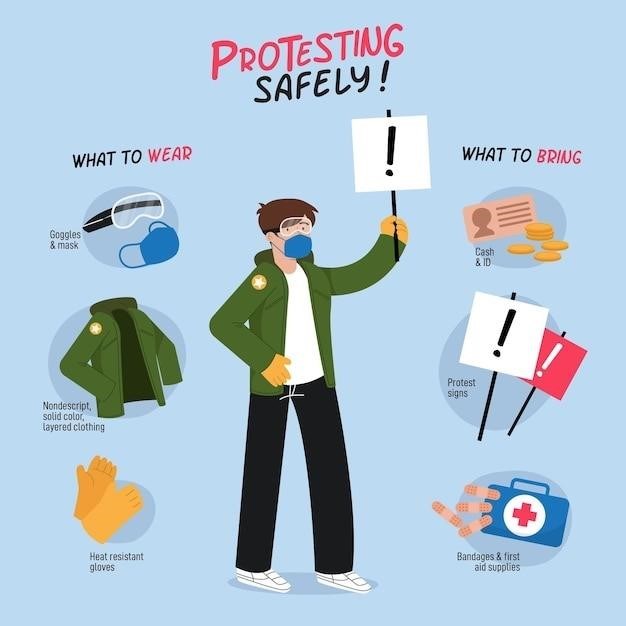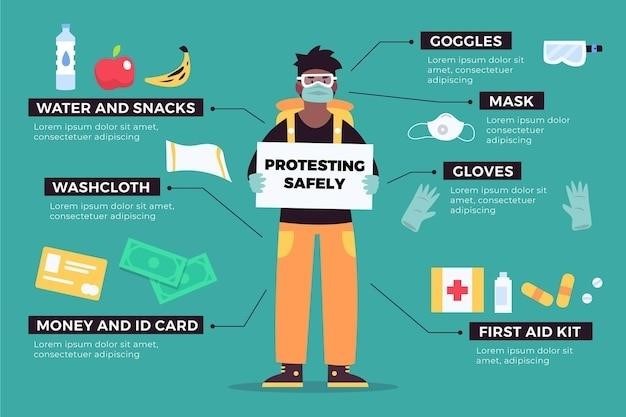safety guide for sos
SOS Safety Guide⁚ A Comprehensive Overview
This guide offers crucial advice for various emergency situations, detailing steps from initial assessment to securing assistance. It emphasizes preparedness, including assembling an emergency kit and practicing response procedures, leveraging technology effectively for efficient communication and help.
Understanding SOS Safety Systems
SOS safety systems encompass a broad range of technologies and procedures designed to enhance safety and facilitate rapid response during emergencies. These systems often integrate multiple components, such as personal emergency response systems (PERS), GPS tracking, and communication tools like two-way radios or mobile apps. The core function is to provide a reliable means of summoning help in situations where immediate assistance is critical. Effective SOS systems are proactive, emphasizing preventative measures alongside reactive responses. They may include features like real-time location tracking, automated alerts, and direct communication with emergency services or designated personnel. A comprehensive system considers various potential hazards and tailors its approach to specific contexts and user needs, ensuring versatility and reliability across diverse situations.
Types of SOS Systems and Their Applications
SOS systems vary widely depending on their intended application. Personal emergency response systems (PERS) are common for individuals at risk of falls or medical emergencies at home. These often involve wearable devices or in-home sensors. For lone workers in remote or hazardous environments, dedicated mobile apps with GPS tracking and emergency alerts are crucial. Vehicle-based SOS systems, integrated into automobiles, automatically notify emergency services in the event of a collision. Workplace safety systems might incorporate panic buttons, surveillance cameras, and access control for enhanced security. Event safety systems deployed during large gatherings provide real-time monitoring and communication for managing potential incidents. The choice of system depends on the specific needs and risks involved, ensuring the most appropriate level of protection and response capability for the situation.
Essential Components of a Robust SOS System
A truly effective SOS system requires several key components. Reliable communication is paramount, encompassing multiple pathways for contacting emergency services or designated personnel. This might involve cellular networks, satellite communication, or two-way radios, ensuring redundancy in case of network outages. Accurate location tracking is vital, utilizing GPS technology, or in its absence, detailed maps and landmarks for precise emergency response. A user-friendly interface is crucial, especially for less tech-savvy users, ensuring ease of activation and clear instructions during stressful situations. Real-time monitoring capabilities allow for proactive intervention, tracking user location and activity, potentially detecting imminent danger before an explicit SOS signal is sent. Post-event analysis features aid in identifying system weaknesses and improving response strategies, learning from past incidents to enhance future preparedness and effectiveness.

Preparing for Emergencies with SOS
Proactive preparation significantly enhances survival odds. This involves creating a comprehensive emergency kit, practicing emergency procedures through drills and simulations, and learning to effectively utilize SOS technology for swift and accurate help.
Building an Emergency Kit⁚ Essential Items
A well-stocked emergency kit is crucial for effective SOS response. Include a first-aid kit with essential supplies like bandages, antiseptic wipes, pain relievers, and any personal medications. Pack non-perishable food items, such as energy bars and canned goods, along with bottled water and a water purification method. A reliable light source, such as a flashlight or headlamp with extra batteries, is essential. Include a multi-tool or pocketknife, sturdy gloves, and a whistle for signaling. Consider weather-appropriate clothing, a blanket, and a waterproof bag to protect valuables. A fully charged power bank for your mobile device ensures communication capabilities. Don’t forget essential documents like identification and insurance cards, kept in a waterproof container. Remember to regularly check and replenish your kit’s contents to ensure readiness.
Practicing Emergency Procedures⁚ Drills and Simulations
Regular practice is key to effective SOS response. Conduct drills simulating various emergency scenarios to familiarize yourself with procedures. Practice assembling your emergency kit, activating your SOS device, and communicating your location clearly. Simulate different weather conditions and potential obstacles to enhance preparedness. Involve family members or colleagues in these drills to foster teamwork and coordination. Review the steps involved in using your SOS system and ensure everyone understands their roles. Regularly test your SOS device’s functionality and battery life to prevent malfunctions during critical moments. Debrief after each drill to identify areas for improvement and refine your response strategy. These exercises will build confidence and ensure a smoother, more efficient response in a real emergency.
Utilizing SOS Technology Effectively⁚ A Step-by-Step Guide
Effective SOS technology utilization hinges on preparedness and clear communication. Begin by familiarizing yourself with your device’s features and functionalities. Understand how to activate the SOS function quickly and efficiently. Ensure your device is fully charged and within range of a cellular or satellite signal. When activating SOS, provide accurate location details and a concise description of the emergency. Remain calm and clearly articulate your needs to emergency responders. Follow any prompts or instructions provided by the system. If possible, provide contact information for emergency contacts. After the emergency, report any system malfunctions or areas for improvement to enhance future responses. Regularly check for software updates and ensure your device’s information remains current. Proactive maintenance guarantees optimal functionality when needed most. Remember, effective use of SOS technology requires both preparation and clear communication during a crisis.

Post-Emergency Procedures with SOS
Following an SOS activation, meticulously document the incident, including details of the event, response times, and outcomes. Analyze the situation to identify areas for improvement in future emergency response. Regularly maintain and update your SOS system to ensure its continued readiness.
Reporting and Documentation⁚ Best Practices
Comprehensive reporting is crucial for effective post-emergency analysis and future preparedness. Maintain detailed records of the incident, including date, time, location, and a clear description of the emergency. Document all communication, including the time SOS was activated, the response time of emergency services, and any communication with individuals involved. Note the actions taken during the emergency, the effectiveness of the SOS system, and any challenges encountered. Include details about injuries, property damage, and any other relevant factors. This thorough documentation aids in identifying areas for system improvements, refining emergency procedures, and enhancing overall safety protocols. Remember to maintain confidentiality, adhering to relevant data privacy regulations when recording personal information.
Analyzing Incidents⁚ Lessons Learned and Improvements
Following any SOS activation, a thorough post-incident analysis is vital. This involves a careful review of all documentation, including emergency response times, communication effectiveness, and the overall system performance. Identify any shortcomings in the emergency response plan, equipment malfunctions, or communication breakdowns. Analyze the effectiveness of training and preparedness measures. Determine if the SOS system functioned as intended and if any improvements could enhance its capabilities. Consider factors such as the environment, human error, and external influences that may have impacted the incident. Based on this analysis, develop specific, measurable, achievable, relevant, and time-bound (SMART) improvements to protocols, training, equipment, or communication systems. This continuous improvement cycle ensures that future responses are more efficient and effective.
Maintaining System Readiness⁚ Regular Checks and Updates
Proactive maintenance is crucial for ensuring the continuous reliability of your SOS system. Regularly inspect all equipment, including batteries, communication devices, and any other components, to identify potential issues before they cause failures during emergencies. Establish a comprehensive testing schedule to simulate various emergency scenarios. This verifies the functionality of all system components and allows for timely adjustments to protocols or equipment. Stay updated on the latest technological advancements and consider integrating new features or upgrades to enhance system capabilities. Implement a system for documenting all maintenance activities and test results. This detailed record-keeping facilitates proactive maintenance, simplifies troubleshooting, and ensures compliance with relevant safety regulations. Regular training for personnel is essential; refresher courses and simulations should be incorporated to maintain proficiency in using the SOS system.
